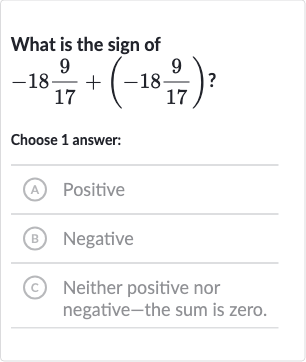Full solution
Q. What is the sign of ?Choose answer:(A) Positive(B) Negative(C) Neither positive nor negative-the sum is zero.
- Identify Terms: Identify the terms in the expression.We have two terms: and . Both terms are identical.
- Calculate Value: Calculate the value of one term.Since both the numerator and the denominator are positive, the term is negative.
- Add Terms: Add the two terms together.Since both terms are the same and negative, adding them together will result in a sum that is also negative.
- Determine Sign: Determine the sign of the sum.The sum of two negative numbers is always negative.Therefore, the sign of the sum is negative.
More problems from Division with rational exponents
QuestionGet tutor help
QuestionGet tutor help
QuestionGet tutor help
QuestionGet tutor help
QuestionGet tutor help
QuestionGet tutor help
QuestionGet tutor help
QuestionGet tutor help

